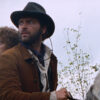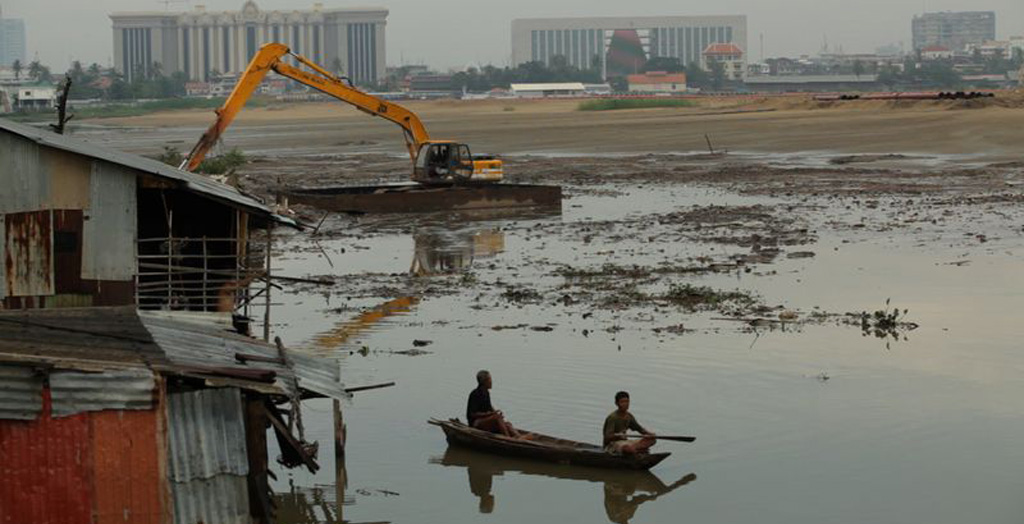Just the other day in Los Angeles, Kalyanee Mam had finished up a screening of her Cambodia-set debut documentary “A River Changes Course” when she was approached by a mother and daughter who were in tears.
“The mother [said] she had left behind her family in Cambodia, and the daughter said, ‘This is the first time she really connected with her mother because her mother never really told her these stories,” says Mam. “Now she understands and now they can do something.”
The story struck a chord with Mam, who also fled the country with her family as a young girl under the threat of the Khmer Rouge regime during the late 1970s. But instead of looking to the past, Mam looks to the future of her homeland with “A River Changes Course,” in which industrial development of the country has led to uncertainty for its indigenous villagers who watch helplessly as fish are less plentiful as a food source and the jungles are being cropped to pave way for factories. The three families in Mam’s film don’t necessarily see this change as a bad thing, yet find themselves scrambling to adapt, lacking the education or resources to change with the environment.
While “A River Changes Course” depicts shaky times for Sari, Sav and Khieu, the three strong villagers who Mam follows as they fend for their families, the film is exceptionally assured, lovingly lensed to bring out the beauty of Cambodia’s people and its lush landscapes while raising all the right questions about the potential toll of globalization and the risk of leaving behind older generations in order to let the new ones succeed. As the film continues to play this week in Los Angeles, Mam took the time to talk about transitioning from her work as a cinematographer on the acclaimed Charles Ferguson economic collapse documentary “Inside Job” to becoming a director with “A River Changes Course,” how she embedded herself with the families in the film and how the stories she found have continued to inspire others.
I was born in Cambodia during the Khmer Rouge regime and my family and I fled the country in 1979 and we came to the United States in 1981. But I always grew up with a strong sense of my Cambodian identity, and during my first trip back to Cambodia was in 1998, 19 years after my family and I fled, I completely fell in love with the country. I saw such a beautiful place and such beautiful people there, but in 2008, I discovered the country had changed dramatically. All the forests and the jungles that I had saw before in 1998 were completely cut down and destroyed. In its place were industrial agricultural crops like rubber, cassava, sugar, and soy and all the rivers and the lakes that were being fished to extinction. People’s livelihood impacted by that, then all the villagers, especially the women from the countryside, were fleeing the country and going to work in the garment factories in Phnom Pehn, the capital city. So in 2008, that was when I felt inspired to make this film and to try to understand the impact that development was having on Cambodia today.
You had just come off the experience of being a cinematographer on “Inside Job,” which looked at the financial meltdown in the U.S. at the very highest levels of government and its impact on the global economy. Was it interesting to have the parallel experience of seeing its impact on a place such as Cambodia so immediately after?
Actually, it was really interesting. I planned to work on this film in 2008, then Charles Ferguson asked me to work on “Inside Job.” That was in the middle of the global financial crisis. People were feeling the impact of that in the United States and all over the world, and I knew at that moment I wanted to work on this project [“Inside Job”] because this was the issue of our time. We’re still feeling the impact of this. But when I worked on “A River Changes Course,” I really saw the parallels between the two projects and the two issues. Here “Inside Job” was talking about the global financial system that had gone awry and in Cambodia, I was living with families who were impacted by this global financial system – the development projects were taking place because of that. People’s lives are being destroyed and their livelihood and their access to their land and their water and their way of life, has been completely destroyed, so “Inside Job” was looking at the financial system, but “A River Changes Course” is looking at the impact of that system directly on people’s lives.
How did you find the families that are the subjects of this film?
At the very beginning, I wanted to focus on three families and three issues that were affecting Cambodia right now – deforestation and the indigenous people who were affected by that, over fishing of the rivers and lakes, and the building of hydroelectric dams that were affecting the fish supply. Then also the fish issue of migration and the factory working conditions in the factories. So I went to specific places where I knew people were being challenged personally [by those issues].
I met Sari [a fisherwoman] on a floating village and that was in 2008, but I couldn’t start working on the film until 2010 after I finished working on “Inside Job.” In 2010, I found Sav Samourn and her family in the jungle, which was not an easy thing to do. I spoke with village chiefs all over the region, and finally one village chief took us on a motorcycle ride across the Sesan River and up nine mountains, deep into the jungle to find Sav Samourn and her family. Then Khieu I met through a friend who introduced me to her and her family. So I started out with three families and when I first met them, I knew that I wanted to follow their lives.

Actually, I always wanted to start the story out deep in the jungle, a place that is untouched by development, and to show how untouched the lives were of Sav Samourn and her family and as the film progressed, you can see how development touches their life. But the sounds in the film are also interesting – at the beginning, you hear the natural sounds of the forest, of the water crashing against the boats, of people pulling and harvesting and whittling rice, but then towards the end of the film, you start hearing more industrial sounds of the factories.
You also hear the sound of the hoe hacking against the soil and the rice mill, which the indigenous family that lived in the jungle were able to save up enough money to buy to mill their rice, which they didn’t have before. That rice mill actually was beneficial for them because they were able to charge their neighbors and to mill their [own] rice, so the film doesn’t really say development or technology is bad. The rice mill is an example of the positive impact of development. But I think what the film forces you to ask is what is the process of the development that’s taking place and is this a process that is really helping people? If not, then how do we change that process?
Technology is such an interesting element in this film because of course, you’re introducing something new simply by filming them, but to me, it speaks to a larger point about what they’re willing to accept or want when it comes to such a cultural shift. They’re very open in front of the camera, perhaps in a way they don’t even understand it, and I wonder in regions such as this, is such a technological shift something they want?
I think they crave it. They want it just as much as any of us. When they see the camera, they’re amazed by it and they wished they could know how to use it and they wish they could have it. Even Khieu says [in the film] she wishes the factory could come to her village. The infrastructure project, the road, the running water, the electricity, the lights – she wants the comforts of all those things just as we crave those comforts too. I don’t think it’s wrong for them to want it just as it isn’t wrong for us to want technology as well. But again, the question is how do we bring about technology to these places? I really think it is possible. There is enough technology that exists today to allow us to have trains, and battery powered cars, and solar panels and all those things could come to a country like Cambodia. It’s just a willingness on the part of the government to bring it.
Did you actually embed yourself there with the families or did you travel back and forth?
It was like a hybrid thing because I lived with the family, but I would only live with them for five, six days at a time, then I would go on to another family and live with them for five, six days at a time. The reason was because it was so exhausting to stay in one place. With all the camera equipment and the heat, I really needed to decompress outside of that. But when I was [in Cambodia], I lived with the families and over the period of two years, I traveled back and forth, though I would be away in Cambodia for about two to five months at a time.
You actually decided to start filmmaking after you graduated from law school. Has that shaped your perspective on what you want to do as a filmmaker?
Definitely. I think everything we do in our lives shapes us, but I’d always been focused on human rights while I was working in the law, so that didn’t change, and as a film maker my legal background did help me to understand the issues better organize my thoughts about how to tell the story.

And that’s not the law degree. I think the reason why I made the film that I made was really because of my own love for art and film and literature and storytelling. For me, the only way to connect with people is not by beating them over the head, but to have a conversation with them and finding ways for us to connect with one another. That’s what I wanted to do with this film was to show how much we have in common, how universal these challenges and issues are, and the idea of trying to make enough to support your family is not just a challenge in Cambodia, it’s a challenge all over the world and has been a challenge for us from the very beginning of time.
What’s it been like to have those conversations as you’ve traveled with the film?
My most enjoyable moments have been the conversations with the community. We first we did [a screening] in Cambodia exactly one year ago and there were 600 people in the audience. Two hundred of them were parents of garment factory workers. All of the families came to the screening from the jungles, from the lakes, from the countryside. There were some incredible responses with people standing up and expressing how touched they were by the beauty of it and the presentation of all the different identities that exist in Cambodia.
Screening here in LA it has been amazing. One young woman stood up in the crowd and she started telling her own story about how she came to the US four years ago, but when she was living in Cambodia, she was working as a garment factory worker at the age of 14. Her mother was fishing for a living and she said she never thought that her story was important or thought about telling it, but now after watching the film she feels so inspired to tell her story. Two students at USC also came up to me and told me that they feel inspired now to go back to their home country of Ghana and make a film about what their home country is going through. That’s the kind of inspiration I want to happen with this film.
This is not a one-dimensional film [telling you], this is what you should be doing or who you should be voting for. It’s really about transformation – of our consciousness, of ideas, of our society — and that comes first and foremost from ourselves. This can happen in Cambodia, and that’s what we’re trying to do. We’re reaching out to 60 universities and villages all throughout Cambodia, screening it to try to raise consciousness about these things.
It actually has an ongoing engagement at the Documentation Center of Cambodia every Friday, which seems like an incredible thing to have that kind of regularity.
Yeah, the Documentation center of Cambodia worked with us to help produce the film and at their office every Friday, they’re screening it, which is amazing because then people can just come and watch it for free. Hopefully, we’ll have it available online soon so that people [who can’t make a screening can] watch it. I really want as many people as possible to watch this film because it’s not about trying to change one thing, but trying to change the way we think about life.
“A River Changes Course” is currently playing at the Music Hall 3 in Beverly Hills. A full schedule of screenings is here.






Comments 1